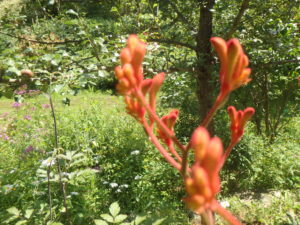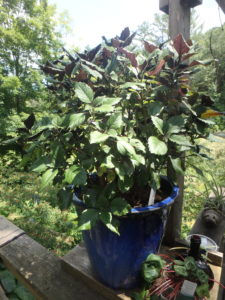How to Grow Kangaroo Paws and Other Less Common Flowers in Containers
Posted on Monday, August 5, 2019 · Leave a Comment
Each summer I fill a big window box with annual flowers and vines to welcome all who approach the house. Some years it is bodacious, other years it verges on ho-hum. This year it is a delight: in the center is a black-leafed sweet potato vine that is surrounded with blue flowers of scavelola and chartreuse vines of licorice plant ( Helichrysum petiolare). All survive in hot and dry locations, and recover from getting dry.
I like to give each plant enough root space, but tend to crowd things a little. A six-inch cube of soil is what I’ve been told is best for potted plants, but plants in my window box don’t get that much space. The key, I’ve decided is to make a blend of potting mix with good compost in equal amounts, and to add a slow-release fertilizer. Straight potting mix has little nutrition for plants, so as the summer progresses it disappears. Of course liquid fertilizer can help with that.

Brugmansia produces masses of huge flowers
This year Cindy splurged and bought a Brugmansia, a large tropical plant that we hope to winter-over in a large pot indoors. It has been displaying an amazing sequence of 12-inch bell-shaped blossoms in a delicate peach color. Other varieties have yellow blossoms. Some varieties of Brugmansia are deliciously fragrant, but ours is not. The plant is in a 20-inch pot and stands 4-feet tall with a main stem, and now two shorter stems. The stems will become woody with time. It is in full sun and needs a drink at sundown after each hot day.
Also in a big pot is a plant I have never before grown: kangaroo paws ( Anigozanthos hybrid ). This is a plant from Australia and does best in a hot, dry location. I have occasionally purchased stems of kangaroo paws from my local florist to add to flower arrangements, so I decided to give it a try. It is doing very well.

Close up of Kangaroo Paws, the buds
Although they come in a variety of colors, the blossoms on mine are orange and really do not look much like flowers. They are fuzzy, and look, well, a bit like kangaroo paws. Eventually the “toes” (buds) produce small flowers. The foliage is similar to Siberian iris, and the flower stems stand up well above it. My flower stems now are nearly 4 feet tall and covered with flower buds. Mine has 2 stems, and a third one developing. It will come inside this winter.
Some years ago many of us suffered the loss of our shade-loving impatiens plants due to a terrible fungal disease. The “Chicken Little” people predicted that although the sky had not yet fallen, we were doomed when it came to growing impatiens. Fortunately, they were wrong. I see it thriving in many places, and I grow it each year in pots to decorate my shady deck. It does not like to be too dry, so I water it frequently in these hot times.
A few years ago I experimented with growing ferns in pots. I dug up two kinds from shady places in my garden: Ostrich fern ( Matteuccia struthiopteris) and maidenhair fern
(Adiantum pedatum). Both did very well on my north-facing deck that gets some morning sunshine, but no afternoon sunshine. I dug them in the spring, which is what I recommend, particularly for the ostrich fern, as the fronds are often 4 to 5 feet long and somewhat fragile.
In the fall, after hard frost, I cut back the fronds and brought the pots indoors. I kept them in a basement that stays around 32 degrees. I made sure they did not dry out too much, but did not want the roots to sit in soggy soil. They both survived nicely and grew again the following spring. Around the ostrich fern I grew some miniature hosta, which also over-wintered.
My mom and grandmother both loved growing red geraniums in pots, and I keep up the family tradition. Now days there are many colors of geraniums, and some with green and white leaves, but I go for the old fashioned ones. Of course you probably know that geraniums are not geraniums at all, but of the genus Pelargonium. Geranium is a genus of perennial flowers that are quite different. That’s why scientific names are all in Latin, so there will be no confusion.
Geraniums like full sun, and do not need to be watered every day, even in full, hot sun and fast-draining soil mix. If your geraniums don’t get enough sun, they will develop long, leggy stems and fail to flower well. But don’t give geraniums lots of fertilizer, as that will inhibit flowering, and promote long stems, too. I bring them in each fall and keep them as houseplants in a sunny, west-facing window. Even so, they get leggy and I cut them back hard in the spring.

Swedish Ivy is not a trailing vine but an upright plant
Last year a friend gave me a nice big potted plant with green leaves that are a deep purple, almost a black, on the underneath side. In the late summer it produced stems loaded with small lavender flowers. Its tag gave its name as Plectranthus ‘Mona Lavender’.
I looked it up for a common name and was surprised to see it is called Swedish Ivy. But it is not an ivy at all, but a robust vertical plant almost 2 feet tall and wide. I place it on the railing of my deck, as it is important to be able to see the underneath side of the leaves, which contrast so well with the dark green top sides. It gets morning sun and requires moderate watering. I overwintered it as a houseplant, cutting it back in the spring.
Each year I resolve to have fewer houseplants, but each year I get more as I try new things for my deck. I guess I’ll just have to build a sun room!
Henry Homeyer is a garden consultant, coach, and author of 4 gardening books. He can be reached at
henry.homeyer@comcast.net.





